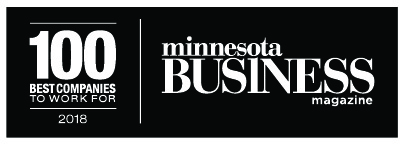Creating a Purpose-Driven Organization
 “If you don’t stand for something, you’ll fall for anything.” This old maxim speaks to the importance of purpose in our personal lives. But purpose matters at work too. In fact, without clear purpose it will be difficult to find — and hold onto – great employees, not to mention making a difference for your customers.
“If you don’t stand for something, you’ll fall for anything.” This old maxim speaks to the importance of purpose in our personal lives. But purpose matters at work too. In fact, without clear purpose it will be difficult to find — and hold onto – great employees, not to mention making a difference for your customers.
In fact, making a difference is the stated purpose of Intertech. We exist to “create a place where people matter and where our partners’ businesses are improved through technology.”
It’s that simple but it’s also that profound. Our purpose has fueled our growth from a tiny startup to a multi-million dollars enterprise that employs nearly 100 people and works with hundreds of organizations throughout Minnesota and the upper Midwest.
“Creating a Purpose-Driven Organization,” an article in the July-August 2018 edition of Harvard Business Review gives an excellent overview of how purpose can energize employees and organizations. Authors Robert E. Quinn and Anjan V. Thakor are business professors who’ve spent a great deal of time studying organizational purpose – or, more commonly, the lack of purpose at work. They surmise “most business practices and incentives are based on conventional economic logic, which assumes that employees are self-interested agents. And that assumption becomes a self-fulfilling prophecy.”
How can companies engender a shared work vision? Quinn and Thakor say “By connecting people with a higher purpose, leaders can inspire them to bring more energy and creativity to their jobs. When employees feel that their work has meaning, they become more committed and engaged. They take risks, learn and raise their game.”
Before you write “purpose” off as another business fad, consider this: ‘. . .when an authentic purpose permeates business strategy and decision making, he personal good and the collective good become one. Positive peer pressure kicks in, and employees are reenergized. Collaboration increases, learning accelerates, and performance climbs.”
That’s not just musings from an academic ivory tower; it’s reality that I see every day at work in my own company. But purpose must truly permeate your business for it to generate these desirable results. The HBR article provides a handy blue print for how to do just that:
- Envision an inspired workforce – This first step involves changing how you think about employees. Get out of the old adversarial mindset and instead “Look for excellence (in your people), examine the purpose that drives that excellence, and then imagine it imbuing your entire workforce.”
- Discover the purpose – The authors note, “you don’t invent a higher purpose; it exists already.” We discovered ours by asking our people to describe the qualities that define our highest functioning team members, as though they were talking to aliens from another planet. That exercise showed us that going the extra mile for clients and each other, being positive, and a high standard of excellence is what we’re really about.
- Recognize the need for authenticity – “When a company announces its purpose and values, but the words don’t govern the behavior of senior leadership, they ring hollow.” Luckily, putting people first and making a difference with technology were the two reasons I founded Intertech!
- Turn the authentic message into a constant message – Imbuing purpose is ongoing work. We’ve found creative, fun ways to reinforce our purpose through employee recognition programs, which I describe in detail in my book “The 100: Building Blocks for Business Leadership.”
- Stimulate individual learning – “As leaders embrace higher purpose they recognize that learning and development are powerful incentives. People actually want to think, learn and grow,” note the professors. I could not have stated that more eloquently myself. Learning is such an important value at Intertech that we build a learning objective into everyone’s annual performance plan. We also provide funding and time off to support the learning objectives.
- Turn midlevel managers into purpose-driven leaders – Not surprisingly, when managers really “get” the purpose, they play a vital role in helping it sink into the collective conscience of the entire organization.
- Connect the people to the purpose – Employees on the frontlines are the ones who make purpose truly come alive. The employee recognition program I mentioned earlier is completely driven by employees who recognize and nominate each other for awards. This process reinforces our purpose: making a difference to each other and our employees. It’s beyond gratifying to see how team members routinely extend themselves to help colleagues and to ensure that customers are delighted. Beyond this, we also take time at our quarterly meeting to share the good being done through the Intertech Foundation.
- Unleash the positive energizers – “Every organization has a pool of change agents that usually goes untapped,” which the authors refer to as “the network of positive energizers.” They recommend identifying them and launching them throughout your organization to “help increase buy-in, tell the truth and openly challenge assumptions.”
The authors cannot guarantee that operating with purpose will lead to positive economic benefits, although they do cite major research pointing to a strong correlation between the two. From my personal experience I can tell you that operating a purpose-driven company not only results in good things for employees and customers, it’s a highly satisfying and rewarding way to do business!
 “That it will never come again is what makes life so sweet.”
“That it will never come again is what makes life so sweet.” The 100 will be available on Audible this fall.
The 100 will be available on Audible this fall. Did you know that asking questions is a skill that can be honed?
Did you know that asking questions is a skill that can be honed?